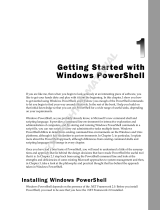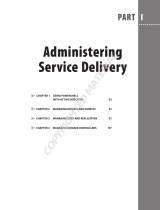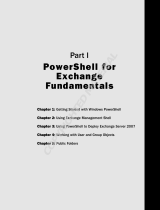Page is loading ...

ii
Technical Report
Windows Command-line
Automation Techniques for
Dell EqualLogic PS Series Arrays
Abstract
This Technical report will describe different
methods of command line automation available
for Windows and Dell EqualLogic PS Series arrays.
Examples are shown with step by step building
guides in order to help administrators create their
own customizable scripts.
TR1089
V1.0

Copyright © 2013 Dell Inc. All Rights Reserved.
EqualLogic is a registered trademark of Dell Inc.
Dell is a trademark of Dell Inc.
All trademarks and registered trademarks mentioned herein are the property of their
respective owners.
Information in this document is subject to change without notice.
Dell Inc. will not be held liable for technical or editorial errors or omissions contained
herein. The information in this document is subject to change.
Reproduction of this document in any manner whatsoever without the written
permission of Dell is strictly prohibited.
Authored By: Chuck Farah
WWW.DELL.COM/PSseries

iii
Preface
PS Series arrays optimize resources by automating performance and network load
balancing. Additionally, PS Series arrays offer all-inclusive array management software,
host software, and free firmware updates.
Audience
The information in this guide is intended for storage administrators.
Related Documentation
For detailed information about PS Series arrays, groups, volumes, array software, and
host software, log in to the Documentation page at the customer support site.
Dell Online Services
You can learn about Dell products and services using this procedure:
1. Visit http://www.dell.com or the URL specified in any Dell product information.
2. Use the locale menu or click on the link that specifies your country or region.
Dell EqualLogic Storage Solutions
To learn more about Dell EqualLogic products and new releases being planned, visit
the Dell EqualLogic TechCenter site: http://delltechcenter.com/page/EqualLogic. Here
you can also find articles, demos, online discussions, technical documentation, and
more details about the benefits of our product family.
For an updated Dell EqualLogic compatibility list please visit the following URL:
https://support.equallogic.com/compatibility

iv
Table of Contents
Table of Contents ............................................................................................................................................. iv
Revision Information ........................................................................................................................................ v
Introduction ......................................................................................................................................................... 1
Executive Summary .......................................................................................................................................... 1
Available Dell EqualLogic Automation from the command line .................................................. 1
PS Series Storage automation: the Goal of this document ............................................................. 2
Windows PowerShell ....................................................................................................................................... 2
PS Series Arrays PowerShell .......................................................................................................................... 2
Other methods of automation available with Dell PS Series Storage (these methods
will not be covered in detail in this document) .......................................................................... 3
PS Series Arrays Group Manager CLI ............................................................................................... 3
PS Series Arrays Host Scripting Tools .............................................................................................. 3
PS Series Arrays Auto-Snapshot Manager (ASM) CLI ................................................................ 3
PS Series Arrays SAN Headquarters CLI ................................................................................................... 3
Windows® and Dell™ PS Series Automation Techniques .............................................................. 4
Windows PowerShell ISE Setup .......................................................................................................... 4
Windows PowerShell Dell EqualLogic PS Series Group Access ........................................ 10
Windows PowerShell Dell EqualLogic PS Series Volume Creation and Access
Automation ............................................................................................................................................... 16
Windows PowerShell Dell EqualLogic PS Series Volume Deletion and iSCSI
Connection removal ............................................................................................................................ 30
Windows Server 2012 Native Windows Storage Management Automation Techniques
................................................................................................................................................................................. 39
Add volumes example with native Windows Server 2012 cmdlets ................................ 39
Removing volumes with native Windows Server 2012 cmdlets ...................................... 45
Conclusion ......................................................................................................................................................... 48
Appendix A: Full Script to add a volume (Windows 2008) ........................................................... 49
Appendix B: Full Script to delete a volume (Windows 2008) ...................................................... 54
Appendix C: Troubleshooting Techniques ......................................................................................... 57
Appendix D: Windows 2008 Integrated Scripting Environment (ISE) setup ........................ 59
Technical Support and Customer Service ........................................................................................... 60

v
Revision Information
The following table describes the release history of this Technical Report.
Report
Date
Document Revision
1.0
June
Initial Release
The following table shows the software and firmware used for the preparation of this
Technical Report.
Vendor
Model
Software Revision
Dell
Host Integration Tools for Microsoft,
includes Auto-Snapshot Manager/ME,
PowerShell tools for De
V4.5, V4.6
Dell
SAN Headquarters
V2.5, V2.6
The following table lists the documents referred to in this Technical Report. All PS
Series Technical Reports are available on the Customer Support site at:
support.dell.com
Vendor
Document Title

Windows Command-Line Automation Techniques for Dell EqualLogic PS Series Arrays
1
Introduction
Dell PS Series Arrays provide powerful command line integration for Windows, Linux
and VMware hosts. Windows PowerShell is the robust scripting interface that will allow
the administrator to customize, automate and optimize their Dell storage operations.
Dell EqualLogic PS series arrays are designed to provide simplicity, advanced
integration and automatic optimization to fully leverage the storage investment.
Dell EqualLogic Host Integration Tools are available for no additional cost and includes
PowerShell Commands unique to the PS Series Arrays as well as storage management
automation through native Windows PowerShell commands for Windows Server 2012
and Windows 8. This document will focus on the Windows interfaces to the PS Series
Arrays.
Executive Summary
The goal of this document is to arm the administrators with skills to help automate
Windows® environments attached to Dell PS Series arrays. Examples and step by step
guides are offered in this document to be used for reference or training to help
demonstrate scripting possibilities with PS Series PowerShell commands (also known
as cmdlets). The document will describe the different forms of application interface
communication available for PS Series arrays as well as some useful Windows specific
commands where appropriate. All of the Dell PS Series software described in this
document is included with the PS Series array.
Available Dell EqualLogic Automation from the command line
Dell PS Series array command line application interfaces available:
PS Series Group Manager CLI
Dell EqualLogic Host Scripting tools for Windows, Linux and Unix
Dell
™
EqualLogic Host Integration Tools for Windows
®
includes Auto-Snapshot
Manager/Microsoft Edition (ASM/ME) – enabling the ability to create data- and
application-consistent Smart Copies of NTFS volumes , and
o Dell EqualLogic PowerShell cmdlets specific to the PS Series.
o Auto-Snapshot Manager CLI
SAN HQ management CLI
Windows® Server 2012 native PowerShell cmdlets through integration with the
Windows® storage architecture and Dell’s PS Series Storage Management
Provider (SMP).
In addition to the PS Series specific APIs native Windows utilities such as DISKPART or
WMI provide the ability to match up operating system objects to the physical
properties necessary to manage the Dell EqualLogic PS Series storage. For instance
DISKPART is used to format and partition iSCSI connected volumes on PS Series arrays
to enable the volume for use in Windows® environments.

Windows Command-Line Automation Techniques for Dell EqualLogic PS Series Arrays
2
PS Series Storage automation: the Goal of this document
This document will use several examples to demonstrate building blocks for advanced
automation with Dell EqualLogic PS Series Windows PowerShell cmdlets, native
Windows PowerShell cmdlets, Windows Management Instrumentation (WMI),
DISKPART and the iSCSI command line interface (CLI) utility.
The Windows PowerShell ISE scripting environment will be used to provide examples
which demonstrate integration with PS Series arrays. The following will be achieved in
this document:
1. How to enable and configure the PowerShell environment for Windows
2. How to list PS Series Array properties such as volumes, members and group
information from PS Series PowerShell cmdlets.
3. How to create, discover, login and initialize a volume to a Windows host
4. How to delete existing volumes from Windows.
5. Show Windows Server 2012 native PowerShell cmdlet integration
a. Automate multiple volume creation
b. Automate multiple volume deletion
Windows PowerShell
Windows PowerShell is quickly becoming the popular scripting tool for advanced
automation. With Windows PowerShell an Integrated Scripting Environment (ISE) is
available to enable rapid development and debugging of the code. The scripting
environment includes small commands which perform specific operations known as
command-lets (cmdlet for short). These cmdlets are the building blocks for the
advanced functionality found in modern Windows scripts today.
Windows® Server 2012 and Windows® 8 have a Storage Management Architecture
that allows for external storage to be managed by native Windows Applications such as
File Services and Systems Center Virtual Machine Manager (SCVMM). The Storage
Management API is available for Dell EqualLogic storage with the Host Integration
Tools for Microsoft® v4.5 (or higher) also known as the HIT for Microsoft. Host
Integration Tools for Microsoft® v4.6 will need to be installed for full support of
SCVMM 2012 SP1.
PS Series Arrays PowerShell
Dell
™
EqualLogic Host Integration Tools (HIT) for Microsoft
®
also includes a suite of
Windows PowerShell cmdlets specific to PS Series arrays. The PowerShell commands
included with the HIT for Microsoft adds specific PS Series Array management
functionality and automation to the Windows PowerShell environment. The PS Series
PowerShell commands include advanced management and discovery of the PS series
Group, Member or Volume and iSCSI Sessions, Replication and Snapshots.

Windows Command-Line Automation Techniques for Dell EqualLogic PS Series Arrays
3
Other methods of automation available with Dell PS Series Storage (these methods
will not be covered in detail in this document)
PS Series Arrays Group Manager CLI
The PS Series array may be configured or viewed through a standard Telnet/SSH
session to perform diagnostics, initial group configuration or management. The PS
Series Group Manager CLI provides typical support call initiated commands or initial
setup of the array, however further administrative tasks may be automated with the
Host Scripting Tools described below. For further information please download the
“Group Manager CLI Reference Guide” from the PS Series Firmware download section
of https://eqlsupport.dell.com
PS Series Arrays Host Scripting Tools
Host Scripting tools are available to issue PS Series Group Manager command line
interface (CLI) commands from a remote host and capture the output of the
commands for further action. The Host Scripting tools are available for Windows, Linux
and UNIX. These host scripting tools allow for manipulation of the PS Series Group
Manager CLI with Perl or Python scripting languages. For further information please
download the “Host Scripting Tools” from the PS Series Firmware download section of
https://eqlsupport.dell.com
PS Series Arrays Auto-Snapshot Manager (ASM) CLI
Dell
™
EqualLogic Host Integration Tools for Windows
®
with Auto-Snapshot
Manager/Microsoft Edition (ASM/ME) may be installed to provide full application
consistent snapshot capabilities. Although the ASM GUI interface provides advanced
automation functionality the ASM CLI provides an application interface to the PS Series
array for additional customization of Smart Copy™ management.
Note: For Windows Smart Copy™ uses the PS Series arrays protection capability to
create application consistent snapshots, clones and replicas to provide protection and
recovery of important information assets.
For further information please download the “Auto-Snapshot Manager Microsoft®
Edition – User’s Guide” from the Host Integration Tools for Microsoft download section
of https://eqlsupport.dell.com
PS Series Arrays SAN Headquarters CLI
SAN Headquarters (SAN HQ) is an advanced performance, configuration and alert
monitoring system for PS Series arrays. Several tasks may be accomplished with the
SAN HQ cli such as report automation, adding PS Series Groups, creating archives and
exports as well as the ability to launch SAN HQ GUI with specific parameters.
For further information please download the “Installation and User’s Guide” from the
SAN Headquarters download section of https://eqlsupport.dell.com

Windows Command-Line Automation Techniques for Dell EqualLogic PS Series Arrays
4
Windows® and Dell™ PS Series Automation Techniques
Windows PowerShell ISE Setup
The PowerShell Integrated Scripting Environment (ISE) will be used to enable
development, testing and debugging of PowerShell scripts or modules to configure
Dell EqualLogic Storage to Windows. Alternatively the Dell PS Series PowerShell Tools
interface may be used, however this document will focus on the use of the Windows
Integrated Scripting Environment (ISE) which is included with Windows® 2008 R2 or
higher (Please see Appendix D for more information). All the examples below use
PowerShell v2.0 available with Windows® 2008 R2 SP1 and PowerShell v3.0 for
Windows® Server 2012 and Windows® 8.
Download and install the Host Integration Tool for Microsoft® v4.5 or higher from
https://eqlsupport.dell.com. The kit will include the Dell EqualLogic PowerShell Tools
Reference Guide v4.5 which will provide detailed information about each cmdlet.
Pre-requisites:
Windows PowerShell Integrated Scripting Environment (ISE)
Please see Appendix D for feature information on Windows 2008.
Host Integration Tools for Microsoft®
Please refer to the Dell EqualLogic PowerShell Tools Reference Guide
https://eqlsupport.dell.com
Warning:
The examples that follow will make changes to your systems and should be
thoroughly tested and modified in a development environment prior to moving to
production. Please use the examples as a reference and be aware that these scripts are
provided as is without warranty of any kind. The PS Series PowerShell cmdlet library
are fully supported through standard Dell agreements.

Windows PowerShell ISE Environment setup
5
To setup up our PowerShell Environment the following will need to be performed
1. As indicated above download and Install Dell EqualLogic Host Integration Tools for
Microsoft (HIT/Microsoft v4.5 or higher)
2. Add the Windows PowerShell ISE feature on Windows 2008 hosts
Please see Appendix D for more information.
3. Enable Microsoft® Windows PowerShell script execution
4. Customize the profile for Windows PowerShell ISE
5. Include the Dell EqualLogic PowerShell cmdlets module in the Windows
PowerShell ISE
Graphical representation of the steps involved. The green will indicate tasks that are
completed while the highlighted square will indicate the current process.
Start
Install HIT
for
Microsoft
*
Add
Windows
ISE*
Enable
PowerShell
Execution
Import
EqualLogic
modules
Customize ISE startup
profile
End
Save and
Test
$profile.ps1

Windows PowerShell ISE Environment setup
6
Step – By – Step Setup for Windows 2008 and Windows 2012/Windows 8
Note: HIT/Microsoft and Windows PowerShell ISE should be setup prior to this step in
the instructions
1. Enable Windows PowerShell execution.
By default the execution policy is set to “Restricted” which means you will not be
able to execute any PowerShell Scripts.
a. Open a Windows PowerShell console
Windows Sever 2012\Windows 8
Server Manager->Tools->Windows PowerShell
Windows 2008/Windows 7
All Programs->Accessories->Windows PowerShell-> Windows PowerShell
b. Determine execution policy: Enter at the command line
PS C:\> Get-ExecutionPolicy
c. If the execution policy is “Restricted” then enter :
PS C:\> Set-ExecutionPolicy RemoteSigned
2. Setup the Windows ISE for PS Series cmdlets module.
a. Open Windows ISE
Windows Server 2012/Windows 8
Server Manager->Tools->Windows PowerShell ISE
Windows 2008/Windows 7
All Programs->Accessories->Windows PowerShell->Windows PowerShell ISE
(Right mouse – Run as administrator)
Start
Install HIT
for
Microsoft
*
Add
Windows
ISE*
Enable
PowerShell
Execution

Windows PowerShell ISE Environment setup
7
b. Import the PS tools (PowerShell cmdlets) module per session:
PS C:\> import-module –name <EqualLogic HIT Install
path>\EqlPSTools.dll
Example: import-module –name “C:\Program
Files\EqualLogic\bin\EqlPSTools.dll”
Test the access and list PS Series cmdlets:
PS C:\> Get-Command –Module EqlPSTools
Example partial output:
PS C:\ > Get-Command -module EqlPSTools
CommandType Name ModuleName
----------- ---- ----------
Cmdlet Connect-EqlGroup EqlPSTools
Cmdlet ConvertFrom-EqlTemplateVolume EqlPSTools
Below are the guidelines to import the PS Tools (PowerShell cmdlets)
permanently and provide persistence between Windows PowerShell ISE
sessions.
c. Create a profile or Open the appropriate profile script: for our example we
will create a profile for all users and all hosts on this machine
d. Edit the profile to include an environmental variable to the path and the
import the EqlPSTools module.
Start
Install HIT
for
Microsoft
*
Add
Windows
ISE*
Enable
PowerShell
Execution
Import
EqualLogic
modules

Windows PowerShell ISE Environment setup
8
e. Create Profile:
Copy the code below to a new PowerShell document and save as
CreateMyProfile.ps1
#########################
if (!(test-path $profile.AllUsersAllHosts))
{new-item -type file -path $profile.AllUsersAllHosts -force}
f. Execute the PowerShell script from the command prompt:
PS C:> .\CreateMyProfile.ps1
Note: The “.\” (dot slash) prefix is a Microsoft security measure to ensure the
authorized user is running the script.
g. Edit the profile to add the module:
PS C:> notepad $profile.AllUsersAllHosts
h. Add these lines with the appropriate locations for the install path:
$env:PSModulePath = $env:PSModulePath + ";C:\Program
Files\EqualLogic\bin\EqlPSTools.dll”
Import-Module –name “C:\Program Files\EqualLogic\bin\EqlPSTools.dll”
Note: Be sure the install path is correct. Further customization is also
available such as “CD” to a default specific working directory.
Start
Customize
ISE Startup
profile
ISE
Setup
Enable
Execution

Windows PowerShell ISE Environment setup
9
i. Save the profile, Exit the ISE and restart.
j. Once the Windows ISE is re-started test with:
PS C:\> Get-Command –Module EqlPSTools
CommandType Name ModuleName
----------- ---- ----------
Cmdlet Connect-EqlGroup EqlPSTools
Cmdlet ConvertFrom-EqlTemplateVolume EqlPSTools
Note: These guidelines will import the EqualLogic PS Tools (PowerShell
cmdlets) permanently and provide persistence between Windows PowerShell
ISE sessions.
See: http://msdn.microsoft.com/en-us/library/dd878326(v=vs.85).aspx for more
information.
Tip: Be sure the install path is correct. Further customization is also available
such as “CD” to a default specific working directory.
Example of a Profile Script:
Customize
ISE Startup
Start
Save and
Test
$profile
ISE
Setup
End

Windows PowerShell Dell EqualLogic PS Series Group Access
10
Windows PowerShell Dell EqualLogic PS Series Group Access
Before being able to execute PowerShell cmdlets that will manage PS Series storage
the PS Series Group(s) will need to be registered and connected. This may be achieved
through Auto-Snapshot Manager/Microsoft Edition or through the provided PowerShell
cmdlets. We will use the PowerShell cmdlets option for this example. See the “Dell
EqualLogic PowerShell Tools v4.5 Quick Reference” for more information.
The Following steps will be performed:
Check for previous connection to the PS Series Groups
Establish new group access if needed
Connect to the PS series groups
Test Connection
Start
Set New
Access
Connect to
the PS Group
End
Test
Connection

Windows PowerShell Dell EqualLogic PS Series Group Access
11
Step – By – Step PS Series Group Access
1. Start the Windows PowerShell ISE
Windows Server 2012/Windows 8
Server Manager->Tools->Windows PowerShell ISE
Windows 2008/ Windows 7
All Programs->Accessories->Windows PowerShell->Windows PowerShell ISE
2. Check for previous PS Series Group access :
Windows Server 2012
PS C:\> Get-StorageSubSystem
This command uses the SMP integration in Windows Server 2012.
PS C:\ > Get-StorageSubSystem
WARNING: No EqualLogic PS Groups configured on this host. Please use EqualLogic
PowerShell Tools or Auto-Snapshot Manager to configure PS Group access.
Windows 2008/ Windows 7
PS C:\> Get-EqlGroupAccess
PS C:\> Get-EqlGroupAccess
WARNING: No connection exists to any Group.
Note: Group access may have been established during the installation of the
Host Integration Tools for Microsoft. Multiple Groups may be registered and
connected to a single host.
All of the commands listed for Windows 2008 will work as well for Windows
Server 2012.
3. Register PS Series Group access (not necessary if already configured but will
need to verify connection in step 5.).
Syntax:
New-EqlGroupAccess –Groupname
<groupname>
-GroupWKaddress
<WellKnownIPaddress>
-username <
DOMAIN>\<username>
–password <
password> -
VSSUserName <chapuserforvss> VSSPassword <chappassword>
Example:
PS C:\> New-EqlGroupAccess -GroupName tekmktlab -GroupWKAddress 10.10.5.50 -
Username grpadmin -Password eqleql -VSSUsername eqlsan -VSSPassword equallogic123
Successfully connected to the group 'tekmktlab'
Note: New-EqlGroupAccess will register the array and connect. This is the
preferred method for connecting to the array as opposed to Connect-EqlGroup.
Start
Set New
Access
Connect to
the PS Group
End
Test
Connection

Windows PowerShell Dell EqualLogic PS Series Group Access
12
Below screen captures will indicate how to locate the input parameters from
the EqualLogic PS Series Group Manager User Interface
-GroupName
-VSSUserName
-GroupWKAddress
Note: -MgmtWKAddress may be
used if a management network
is used on this Group
-VSSPassword

Windows PowerShell Dell EqualLogic PS Series Group Access
13
4. Check for all PS Series access and Connection information
PS C:\Get-EqlGroupAccess|Format-Table –property GroupName, SessionID
If the SessionID does not show as <disconnected> please continue to Step 6.
PS C:\> Get-EqlGroupAccess |format-Table -property groupname,sessionid -AutoSize
GroupName SessionId
--------- ---------
TR2ProdGrp 64ED2A45484434AA50FB440000009035
Note: a SessionId populated indicates a successful connection to the Group.
The Format-Table cmdlet allows for column selection and output format
customization.
Multiple Groups may be connected to this Server (see example below):
PS C:\> Get-EqlGroupAccess|Format-Table -Property GroupName,SessionID -Autosize
GroupName SessionId
--------- ---------
ArmyGroupT1 60006585C852CD2A141FE50100002000
tekmktlab 6090A02860F2A2B53C6F1483020020C7
tekmktlab-10Gb 6090A09840D4057EA9D5A4000000D086
To select just an individual Group use the following cmdlet:
PS C:\> Get-EqlGroupAccess|Where-Object {$_.GroupName -eq 'tekmktlab'}|Format-
Table -Property GroupName,SessionID -Autosize
GroupName SessionId
--------- ---------
tekmktlab 6090A02860F2A2B53C6F1483020020C7
The Where-Object cmdlet is a handy way to filter selections.
5. *** Only Connect if the Group is currently disconnected ***
PS
C:\Get-EqlGroupAccess|Format-Table –property GroupName, SessionID
PS C:\> get-eqlgroupaccess |ft -property groupname,sessionid -AutoSize
GroupName SessionId
--------- ---------
TR2ProdGrp <disconnected>
If <disconnected> Connect to the PS Series array
PS C:\> Set-EqlGroupAccess -GroupName TR2ProdGrp -UserName grpadmin `
-Password eqleql
Successfully connected to the group 'TR2ProdGrp'
The success statement indicates that the credentials and connection
information is correct. The Set-EqlGroupAccess is the preferred method to re-
establish connections if needed.
Note: In some cases you may need to re-register with the “Remove-
EqlGroupAccess –GroupName $GroupName” and then “New-EqlGroupAccess”.
Start
Set New
Access
Connect to
the PS Group
End
Test
Connection

Windows PowerShell Dell EqualLogic PS Series Group Access
14
6. To test connection and access to the Group:
PS C:\> Get-EqlGroup
SessionId : 6090A09840D4057EA9D5A4000000D086
groupId : 6090A09840D4057EA9D5A4000000D086
GroupName : tekmktlab-10Gb
GroupAddress : 10.10.6.50
GroupAddressIPv4 : 10.10.6.50
GroupAddressIPv6 : 0000:0000:0000:0000:0000:0000:0000:0000
ClientAccessSSH : enabled
ClientAccessTelnet : enabled
WebAccess : enabled
WebAccessNoEncrypt : enabled
ConnectionBalancing : enabled
PerformanceBalancing : enabled
GroupDate : 06/11/13
GroupTime : 10:22:44
GroupTimeZone : america_New_York
GroupDescription : 10 Gigabit Storage Group
UseCHAPForDiscovery : disabled
EmailHomeContact :
SMTPServers : 10.124.4.210
EmailSender : [email protected]
EmailSenderDomain : dell.com
EmailSenderName : joe
EmailRecipientList : joe@dell.com;
EmailNotification : disabled
FTPService : enabled
UseLocalChapForIscsi : enabled
GroupLocation : TechMkt R1
MembershipPassword : ****************
SyslogNotification : enabled
NTPServers : 10.124.4.103
SyslogServers : 10.124.4.210;10.17.225.67;172.16.213.184
RadiusIscsiAuthentication : disabled
RadiusLoginAuthentication : disabled
RadiusAuthenticationServers :
RadiusAuthenticationSecrets :
RadiusAuthenticationTimeoutSeconds : 2
RadiusAuthenticationRetryCount : 1
RadiusUserAccounting : disabled
RadiusAccountingServers :
RadiusAccountingSecrets :
RadiusAccountingTimeoutSeconds : 2
RadiusAccountingRetryCount : 1
LDAPLoginAuthentication : disabled
OptimizedMPIOSessions : Enabled
UnlimitedMPIOSessions : Disabled
MinimalMPIOSessions : Disabled
Note: This connection may also be shown with the native Windows Server
2012 PowerShell cmdlets “Get-StorageSubsystem” as well as the Auto-
SnapShot/ME GUI.
Start
Set New
Access
Connect to
the PS Group
End
Test
Connection

Windows PowerShell Dell EqualLogic PS Series Group Access
15
Note: Auto-Snapshot Manager/Microsoft® Edition PS Group Access example.
Tip: Any command may be explained with Get-Help cmdlet <options> where
options may be –detailed, -examples etc.
/





